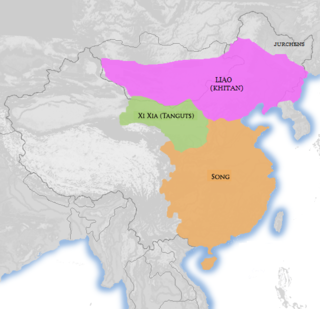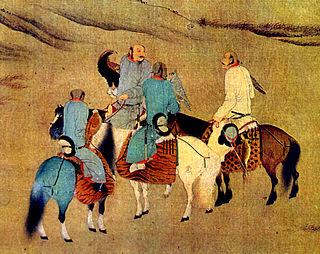Turkestan, also spelled Turkistan, is a historical region in Central Asia corresponding to the regions of Transoxiana and Xinjiang.

The history of the Khitans dates back to the 4th century. The Khitan people dominated much of Mongolia and modern Manchuria by the 10th century, under the Liao dynasty, and eventually collapsed by 1125.

The Qara Khitai or Kara Khitai empire (1124–1218), also known as the Western Liao dynasty, officially the Great Liao, was a sinicized dynastic empire in Central Asia ruled by the Khitan Yelü clan, and a successor state to the Liao dynasty. The dynasty was founded by Yelü Dashi, who led the remnants of the Liao dynasty from Manchuria to Central Asia after fleeing from the Jin dynasty conquest of their homeland in northern China. The empire was usurped by the Naimans under Kuchlug in 1211; traditional Chinese, Persian, and Arab sources consider the usurpation to be the end of the dynasty, even though the empire would not fall until the Mongol conquest in 1218. The Qara Khitai is considered by historians to be a legitimate dynasty of China, as is the case for the preceding Liao dynasty.
Khitan or Kitan, also known as Liao, is a now-extinct language once spoken in northeast Asia by the Khitan people. It was the official language of the Liao Empire (907–1125) and the Qara Khitai (1124–1218).
Yelü Dashi, courtesy name Zhongde (重德), also known by his temple name Emperor Dezong of Western Liao (西遼德宗), was the founder of the Qara Khitai. He initially ruled as king from 1124 to 1132, then as emperor from 1132 to 1143. He was also known in Muslim sources as Nūshī Taifū, Qushqin Taifū or Qushqīn, son of Baighū. He fled the Liao dynasty in northern China as it was on the verge of destruction by the Jurchen-led Jin dynasty and moved westward into Central Asia where he established a new empire.
Yelü Diela was the younger brother of the Liao dynasty founder Yelü Abaoji, invented the "Khitan small script" to accommodate the more agglutinative Khitan language about 925 — based partly on the earlier "Khitan large script" or Chinese-like logographic writing, but also after having been inspired by the vertically written Old Uyghur alphabet that was shown to him by an ambassador.

The Khitan large script was one of two writing systems used for the now-extinct Khitan language. It was used during the 10th–12th centuries by the Khitan people, who had created the Liao Empire in north-eastern China. In addition to the large script, the Khitans simultaneously also used a functionally independent writing system known as the Khitan small script. Both Khitan scripts continued to be in use to some extent by the Jurchens for several decades after the fall of the Liao Dynasty, until the Jurchens fully switched to a script of their own. Examples of the scripts appeared most often on epitaphs and monuments, although other fragments sometimes surface.
The Yelü clan of the Khitan people assumed leadership of the Khitan state in 907 when Abaoji became khan of the Khitan people and maintained that leadership through the fall of the Liao dynasty in the 1120s. Even following this fall, members of the clan appear in history, most notably during the Mongols era of conquest in the thirteenth century, most notably Yelü Chucai, the last recorded person to be able to speak and read the Khitan language.

The Liao dynasty was a Khitan-led imperial dynasty of China. This article discusses the provincial system that existed within the Liao dynasty from the early 10th century until the fall of the empire in 1125, in what is now North China, Northeast China and Mongolia.

The Khitan people were a historical para-Mongolic nomadic people from Northeast Asia who, from the 4th century, inhabited an area corresponding to parts of modern Mongolia, Northeast China and the Russian Far East.

Jurchen script was the writing system used to write the Jurchen language, the language of the Jurchen people who created the Jin Empire in northeastern China in the 12th–13th centuries. It was derived from the Khitan script, which in turn was derived from Chinese. The script has only been decoded to a small extent.
The History of Liao, or Liao Shi, is a Chinese historical book compiled officially by the Mongol-led Yuan dynasty (1271–1368), under the direction of the historian Toqto'a (Tuotuo), and finalized in 1344. Based on Khitan's primary sources and other previous official Chinese records, it details the Khitan people, Khitan's tribal life and traditions, as well as the official histories of the Liao dynasty and its successor, the Western Liao dynasty.

The Khitan small script was one of two writing systems used for the now-extinct Khitan language. It was used during the 10th–12th century by the Khitan people, who had created the Liao Empire in present-day northeastern China. In addition to the small script, the Khitans simultaneously also used a functionally independent writing system known as the Khitan large script. Both Khitan scripts continued to be in use to some extent by the Jurchens for several decades after the fall of the Liao Dynasty, until the Jurchens fully switched to a script of their own. Examples of the scripts appeared most often on epitaphs and monuments, although other fragments sometimes surface.

The Liao dynasty, also known as the Khitan Empire, officially the Great Liao, was an imperial dynasty of China that existed between 916 and 1125, ruled by the Yelü clan of the Khitan people. Founded around the time of the collapse of the Tang dynasty, at its greatest extent it ruled over the North China Plain, Northeast China, Southern Dauria, the Mongolian Plateau and the northern part of the Korean Peninsula.
Aisin-Gioro Ulhicun is a Chinese linguist of Manchu ethnicity who is known for her studies of the Manchu, Jurchen and Khitan languages and scripts. She is also known as a historian of the Liao and Jin dynasties. Her works include a grammar of Manchu (1983), a dictionary of Jurchen (2003), and a study of Khitan memorial inscriptions (2005), as well as various studies on the phonology and grammar of the Khitan language.
Jin Guangping or Aisin-Gioro Hengxu (1899–1966) was a Chinese linguist of Manchu ethnicity who is known for his studies of the Jurchen and Khitan languages and scripts.
Khitan names are the personal names of the Khitan people which ruled the Liao Dynasty (907–1125) in ancient China and Kara-Khitan Khanate (1124–1218) in Central Asia. A nomadic Mongolic people, the Khitans have been extinct, making research on their cultures difficult. Currently the Khitan language has largely not been deciphered, and the presence of 2 different writing systems - the Khitan large script and the Khitan small script, make research more difficult. The problem is compounded by the fact that most of the Liao history were recorded in written Chinese such as History of Liao, and transliteration into Chinese characters are not always standard even in modern days, much less in ancient days when the pronunciation is different as Chinese is logographic.

The Liao dynasty was a Khitan-led dynasty of China that ruled over parts of Northern China, Manchuria, the Mongolian Plateau, northern Korean Peninsula, and what is modern-day Russian Far East from 916 until 1125 when it was conquered by the Jin dynasty. Remnants of the Liao court fled westward and created the Western Liao dynasty which in turn was annexed by the Mongol Empire in 1218.








